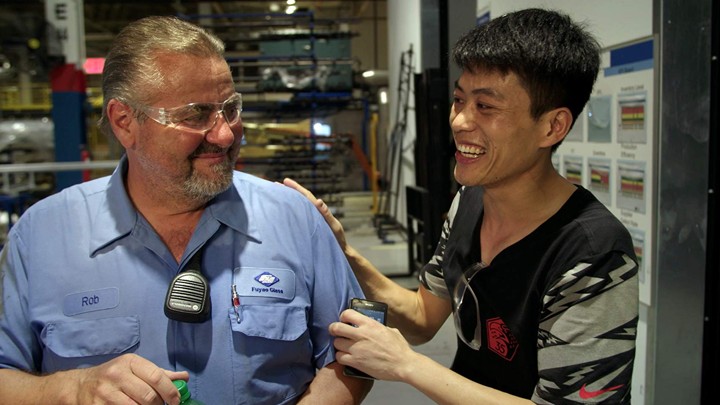
To get back into the IA movie showings, I attended the screening of “American Factory,” a documentary that tells the story of a GM plant that was turned into a Chinese manufacturing company. The building itself is located in Dayton, Ohio, a city very close to my own, Cincinnati.
In 2008, GM closed the doors on this plant due to the recession that affected many American families and left 2,000 families without jobs in Dayton. A Chinese company named Fuyao took the building space over with a goal to prosper in the United States. This company manufactures glass for automobiles. The company hired about 1,000 Americans when it first opened its doors on U.S. ground, and also brought over a number of Chinese workers to be managers and teach new employees how to work machinery. The rest of the documentary set out to recount the events that followed this merge of the U.S. and China in one single company, Fuyao Glass America.

The issues that arose throughout the movie most often had to do with cultural differences. Near the beginning, the chairman and founder of Fuyao flew to America to see the building and complained that some things were not correct or how he wanted them to be. For instance, he wanted the fire alarm to be moved in order to put artwork on the walls of one of the lobby areas. He did not seem to understand that it was by regulation and law that the alarm was placed on the wall how it was, and this was a common theme later as well. The Chinese did not seem to understand the concern for safety that the Americans in the company had. Manufacturing glass requires employees to be near very hot furnaces near 400 degrees Fahrenheit, and this is dangerous for humans after prolonged exposure. American workers continuously felt as though the Chinese were pushing them too hard and only telling them what to do without actually telling them why.
In another part of the documentary, Fuyao sent some of the American workers to China to see a Chinese Fuyao building. The cultural differences were very obvious during this visit; the Chinese workers worked much faster than the ones in America, they were under much more pressure, and were only able to see their families every so often. One Chinese supervisor explained that they only get 1-2 days off of work a month and work 12 hour shifts, while Americans get weekends (about 8 days a month) and only have to work about 8 hours.
I think that this fact really emphasizes the cultural difference between Americans and the Chinese in regards to how we view our work lives. The Chinese see the point to living as work, while Americans view life as more than work; there is something more to living. I do not think that the employees properly understood this difference, and it caused many problems within the company as seen in the movie, such as when a certain number of American workers wanted to form a union. The Chinese did not want this to happen, as they saw unions as a danger to the wellbeing of their company. If their employees created a union, there would be a chance that they could use the power of numbers to rise up against the people in charge of a company. Instead, they emphasize that each employee has a voice, and that they value the direct connection between the employer and the employee.

For example, the Chinese put on a New Years party for the company as a whole in China in which to participate together to celebrate. This can be seen as a way to show that everyone is equal and valued, for they are invited to partake in the celebrations. The party included food, dance performances, songs (some of which praised the glory of Fuyao as a company), and what even appeared to be a group wedding between multiple couples. However, this can also relate to the point that work and life are one in the Chinese culture, as the company is celebrating a national holiday together as a “family.”
Throughout this movie and analyzing the cultural differences that became clear in the documentary, I kept thinking about how useful a cultural fluency training would have been for both the American and Chinese employees. I went through this fluency training last year, and it was very helpful to learn about how other cultures view parts of life such as work, leisure time, and respecting elders. I wonder how many issues could have been resolved, or even nonexistent, if only the company pursued to do a formal and rigorous cultural training at the beginning of the merge. I think that this idea could be extended to other companies with employees from different countries and cultures. Why not invest in the well-being of your company by having people go through training in order to understand how to work together?
Although there were many issues covered in this film, one man found friends within the Chinese community at the company. Rob, an American employee, connected with the Chinese man who was teaching him how to use some of the machinery named Wong. Rob continuously expressed his gratitude for all of the things Wong taught him, and referred to the Chinese he worked with as his brothers because he would do anything for them. He even invited 13 Chinese employees, including Wong, over to his house for Thanksgiving. His experience was hopeful, for there is always the chance to work with others and get to know them; it just takes mutual understanding and an openness to talk about each other’s cultural differences.
